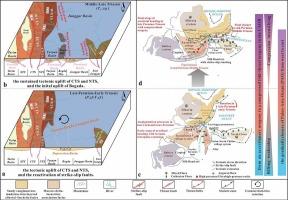The Permo-Triassic internal source-to-sink systems of central Asian orogenic belt recorded extensional to compressional accretionary orogeny
IF 7.2
1区 地球科学
Q1 GEOSCIENCES, MULTIDISCIPLINARY
引用次数: 0
Abstract
The Central Asian Orogenic Belt (CAOB), an accretionary orogen with components of oroclinal bending locally, underwent complex accretionary-compressional orogenesis and characterized by a series of ranges and basins within its landscape since the Paleozoic. But how did the CAOB’s tectonic history couples with its interior basin evolution remains unclear. Based on detrital zircon U-Pb geochronology, and Lu-Hf isotope analysis, we quantitatively investigate the variations of the source-to-sink system from the Late Permo-Triassic sedimentary rock of the CAOB’s Bogda region and constrain the related tectonic evolution history and geodynamic processes. The results show that the Late Permo-Triassic sediments in the Bogda are mainly derived from the Central Tianshan, followed by the North Tianshan, East Junggar, and internal Bogda basement that launched in the Middle-Late Triassic, implying these surrounding ranges, the Tianshan, East Junggar, and Bogda, successively experienced varied uplift. Combined with the reported igneous age population, interpretation of basinal seismic profiles, and sedimentological stratigraphic frame, our results of the source-to-sink restoration reveal Bogda underwent the evolution process that was from the Early-Middle Permian a back-arc rift basin of strike-slip feature to the Late Permian-Early Triassic a depression basin, and evolved into a strongly compressed foreland basin during the Middle-Late Triassic. The Late Permian-Early Triassic tectonic inversion recorded by the unconformity was a response to the counterclockwise rotation of blocks that was caused by the oroclinal bending of the CAOB collage process, which possibly resulted from long-term effects of the final closure of Paleo-Asian Ocean (PAO) from west to east during the Permo-Triassic. These episodes of the basin and ranges system evolution signify the transition of the CAOB from an extensional accretionary orogeny to a compressional accretionary orogeny.

中亚造山带二叠系—三叠系内部源—汇体系记录了伸展—挤压增生造山作用
中亚造山带是一个局部具有造山斜弯曲成分的增生造山带,古生代以来经历了复杂的增生-挤压造山作用,其地貌内形成了一系列山脉和盆地。但CAOB的构造历史是如何与内部盆地演化相结合的,目前还不清楚。基于碎屑锆石U-Pb年代学和Lu-Hf同位素分析,定量研究了渤格达地区晚二叠世—三叠纪沉积岩源-汇体系的变化规律,并约束了相关的构造演化历史和地球动力学过程。结果表明,晚二叠世—三叠纪盆地的沉积主要来自中天山,其次是北天山、东准噶尔,以及中晚三叠世喷发的博格达内部基底,表明其周围的天山、东准噶尔和博格达先后经历了不同程度的隆升。结合已报道的火成岩年龄、盆地地震剖面解释和沉积学地层格架,我们的源-汇恢复结果表明,博格达经历了从早-中二叠世走滑特征的弧后裂谷盆地到晚二叠世-早三叠世坳陷盆地的演化过程,并在中晚三叠世演化为强挤压前陆盆地。不整合记录的晚二叠世—早三叠世构造反转是对CAOB拼贴过程的斜向弯曲引起的地块逆时针旋转的响应,可能是二叠纪—三叠纪古亚洲洋(PAO)最终自西向东闭合的长期影响所致。这些盆地和山岭体系演化的阶段,标志着黄土高原由伸展增生造山运动向挤压增生造山运动的转变。
本文章由计算机程序翻译,如有差异,请以英文原文为准。
求助全文
约1分钟内获得全文
求助全文
来源期刊

Gondwana Research
地学-地球科学综合
CiteScore
12.90
自引率
6.60%
发文量
298
审稿时长
65 days
期刊介绍:
Gondwana Research (GR) is an International Journal aimed to promote high quality research publications on all topics related to solid Earth, particularly with reference to the origin and evolution of continents, continental assemblies and their resources. GR is an "all earth science" journal with no restrictions on geological time, terrane or theme and covers a wide spectrum of topics in geosciences such as geology, geomorphology, palaeontology, structure, petrology, geochemistry, stable isotopes, geochronology, economic geology, exploration geology, engineering geology, geophysics, and environmental geology among other themes, and provides an appropriate forum to integrate studies from different disciplines and different terrains. In addition to regular articles and thematic issues, the journal invites high profile state-of-the-art reviews on thrust area topics for its column, ''GR FOCUS''. Focus articles include short biographies and photographs of the authors. Short articles (within ten printed pages) for rapid publication reporting important discoveries or innovative models of global interest will be considered under the category ''GR LETTERS''.
 求助内容:
求助内容: 应助结果提醒方式:
应助结果提醒方式:


